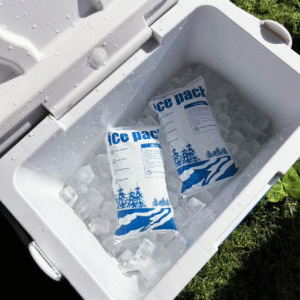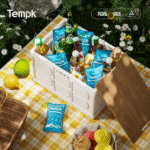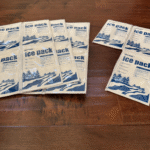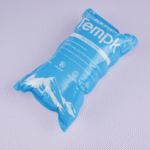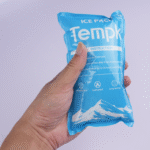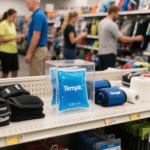Bulk Dry Ice Packs: How Do You Size and Ship in 2025?
Si vous expédiez des marchandises surgelées, bulk dry ice packs are the most reliable way to hold −78.5 °C performance for 24–120 hours. Below you’ll get a fast sizing formula, proven pack‑outs, film and vent specs, et 2025 compliance pointers to pass acceptance checks and reduce waste. This guide blends your three source drafts into one practitioner playbook with action steps you can ship today.
-
How many bulk dry ice packs you need per lane using quick sizing math and long‑haul adjustments
-
Which films and venting prevent bursts while minimizing dust and cracks at −78.5 °C
-
Pack‑out layouts that actually hold across 24–120 hours with EPS, Pur, and VIP shippers
-
Regulatory and safety checkpoints to clear IATA/UN 1845, OSHA CO₂, and labeling rules
-
2025 trends and procurement levers to cut cost and footprint without risking temperature
How many bulk dry ice packs do you need for 24–120 hours?
Réponse courte: Use a simple heat‑load proxy and convert to dry ice mass; then split by bricks (hold) et des draps (surface). Bulk dry ice packs should appear in the first 50 mots, and they do here by design.
Practical formula (works in pilots):Dry Ice (kg) ≈ 0.10 × Box Volume (L) × Transit Days × Insulation Factor
-
Insulation Factor (IF) guide: VIP 0.6–0.7 · PUR 0.8 · EPS 1.0 · Corrugated 1.4–1.6
-
Exemple: 20 L EPS, 2.5 days → 0.10×20×2.5×1.0 ≈ 5.0 kg → ten 0.5 kg packs
Pourquoi ça marche: The coefficient folds typical parcel heat gain and sublimation behavior into a single step, so your team can size in seconds and tune with data loggers rather than guess.
Make it lane‑smart: Ajouter +10% (chaud, 20–30 ° C) ou +20% (chaud, >30 ° C), and increase side/top coverage for summer air moves. Convert mass to counts by your standard pack sizes.
What if you can’t run a pilot right now?
Use the 5–10 lb per 24 h heuristic for EPS shippers, then add 20–40% buffer in summer or for air. Blocks reduce surface area (longer life); sheets improve contact (tighter gradients). Commencer par bottom 50% / sides 35% / top 15% and adjust after the first logger run.
| Lane Type (20 L) | Start Mass per 24 h | Typical Mix | Ce que cela signifie pour vous |
|---|---|---|---|
| EPS e‑commerce (24–48h) | 2.0–2.5 kg | Briques + feuilles | Easy to stage; predictable cost |
| PUR upgrade (48–72h) | 1.6–2.0 kg | More bricks | Lower total ice; better stability |
| VIP export (72–96h) | 1.2–1.6 kg | Laminated packs | Murs plus minces; premium hold |
Field tips to avoid over‑ or under‑packing
-
Condition préalable product and shipper; dry ice maintains temperature, it doesn’t freeze warm goods fast.
-
Leave headspace (10–15 mm under the lid) Alors Co₂ peut s'échapper; never tape airtight.
-
Count, don’t scoop: Standardized pack sizes reduce variance and re‑ice events.
Cas réel: A frozen dessert brand moved from EPS to PUR and standardized PET/PE 130 µm vented packs. Failures fell 72% and dry ice use dropped 18% while staying below −18 °C at delivery.
Which films, thicknesses, and vents keep bulk dry ice packs from cracking or bursting?
Conseils de base: HDPE 110–120 µm works for most lanes <72 H; PET/PE 130–150 µm suits 72–96 h or rough handling. Micro‑venting is mandatory so CO₂ can bleed off without ballooning.
Design choices explained in plain language: At −78.5 °C many plastics get brittle. Thicker, tougher films resist puncture, but too thick can crease‑crack. Solve it with rounded folds, ≥6 mm seams, and small vents that let gas out while keeping pellet dust in.
Film & vent selector for bulk dry ice packs
| Type de film | Typical Gauge | Low‑Temp Toughness | Venting Cue | Pour toi |
|---|---|---|---|---|
| LDPE 70–90 µm | Mince | Fair | Risky without vents | Only for short, gentle lanes |
| HDPE 110–120 µm | Standard | Bien | Micro‑vents, 2 points | Default for frozen e‑com |
| PET/PE 130–150 µm | Robust | Very good | Laser pinholes | Pharma/long haul abuse |
| Metallized PET/PE 140–160 µm | Stiff | Bien | Requires vents | Adds radiant shielding |
Vent area and placement that ops can repeat
-
Total vent area: ~0.5–1.5 mm² per 5 kg de glace sèche (split across top seam + side panel).
-
Seams: ≥6 mm weld with rounded ends to avoid tear starts.
-
Geometry: Anti‑burst patterns and sleeves pay for themselves in reduced damage.
How should you pack bulk dry ice packs around food, Pharma, or lab cargo?
Principle: Entourer la charge utile, Évitez le contact direct, and preserve headspace for gas. Bulk dry ice packs go sous / along sides / en haut with a thin liner to prevent cold burn.
Three pack‑outs you can paste into your SOP:
-
24–48h (EPS 10–20 L): 2–4 packs bottom · 2–4 long sides · 1–2 top · corrugated liner
-
48–72h (EPS 20–40 L): Bricks bottom (40–60%) · sheets sides (30–40%) · top‑off (10–20%)
-
72–96h (VIP/PUR): Laminated packs in sleeves · corner guards · logger near warm point · vents clear
Quick comparison: dry ice vs gel vs PCM
| Réfrigérant | Bande de température | Durée typique | Humidité | Cas d'utilisation |
|---|---|---|---|---|
| Bulk dry ice packs | −78.5 °C to ~−60 °C (efficace) | 24–120h | Sec | Keep products frozen solid |
| Packs de gel (à base d'eau) | 0 °C to −2 °C | 6–36h | Wet | Produce, boissons |
| Briques PCM (various) | −20 ° C / −10 ° C / +2–8 ° C | 24–96h | Sec | Pharma ranges, mixed loads |
Practical tips you can act on today
-
Use bricks for base load et sheets for contact to flatten gradients.
-
Add 10–20% mass for last‑mile variability; reduce after you log two clean runs.
-
Protect film from sharp corners with sleeves or pads; damage spikes sublimation.
What safety and compliance rules matter in 2025 for bulk dry ice packs?
Non-négotibles: Packaging must be ventilé, marqué «Glace sèche» / Et1845, et montrer masse nette pour l'air. Passenger baggage limits often use the 2.5 kg per‑package exception (with airline approval and non‑airtight packaging). OSHA places CO₂ PEL at 5,000 ppm (8‑hr TWA); plan ventilation where pallets stage. Dry ice releases about 541 L of CO₂ per kg over its life—size vents and air exchange with that in mind.
Ground truth for your SOP: Vent both inner packs and outer shipper, keep labels clear of vent paths, and never store in sealed rooms or vehicles. Train teams on PPE (gants isolés, protection des yeux) and handling at arm’s length.
“Pass acceptance” checklist (copy to your QA sheet)
-
Vented packs et vented outer shipper confirmed
-
Et1845 + net mass in kg applied; hazard diamond visible
-
Net mass aligns with airway bill; passenger exception not misused
-
Logger placed at warm point; buffer mass documented in summer
2025 developments shaping bulk dry ice packs
Quoi de neuf cette année: Expect tighter airline acceptance checks, broader use of dock CO₂ monitoring, et film innovations (bio‑laminated PET/PE, nano‑barriers, smart over‑pressure indicators). Procurement teams are baking surge clauses into RFQs due to CO₂ feedstock swings. The net effect: bulk dry ice packs programs that pair better insulation with engineered venting cut dry ice use 10–25% while improving arrival stability.
What changed and why it matters
-
Acceptance discipline: Counters are enforcing venting and net‑mass fields more consistently.
-
Smarter staging: Affordable CO₂ monitors make dock alarms standard practice.
-
Sustainable films: Recycled‑content laminates improve low‑temp impact without brittleness.
Vue sur le marché: Price bands still vary by region, form, and lead time. Blocks often deliver longer life per pound; pellets save labor during pack‑out. Quote both and pilot labor vs. déchets.
FAQ
How long do bulk dry ice packs last in real shipments?
Plan 2.0–2.5 kg per 24 h per 20 L pour PSE. PUR/VIP shippers reduce that by 20–40%. Always verify with data loggers before standardizing.
Can I seal a bulk dry ice pack to slow loss?
Non. Airtight bags or boxes can burst. Use micro‑vents or laser pinholes and keep lid vents clear.
What’s the safest way to avoid freeze‑burn on food?
Ajouter un thin corrugated or foam separator so product never touches the pack; load packs under, autour, and above.
Which is better for 72–96 h lanes: pellets or blocks?
Blocs anchor hold time (lower surface), sheets/pellets fill voids for uniformity. Mix them for best results.
How much CO₂ gas should I plan for on a pallet?
À propos 0.541 m³ per kg de glace sèche. Vent vehicles and docks; never store in enclosed spaces.
À propos du tempk
Nous ingénieurs evidence‑based cold‑chain packaging—from bulk dry ice packs (HDPE and PET/PE films) to VIP/PUR shippers—combining geometry, ventilation, and insulation to hit time‑temperature targets with less refrigerant. Our pilots, data logging, and SOP training reduce spoilage, claims, and re‑ice events—and we back it with measurable KPIs. Ready for a lane‑specific plan? Request a free pack‑out spec and we’ll size mass, film, and vents for your routes.






